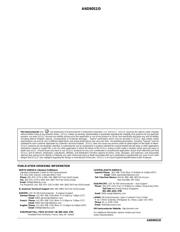下载

Semiconductor Components Industries, LLC, 1999
February, 2001 – Rev. 0
1 Publication Order Number:
AND8052/D
AND8052/D
High-Performance CMOS
Analog Switches
Prepared by: Fred Zlotnick
Logic Applications Engineering
INTRODUCTION
Eleven new devices have recently been introduced by ON
Semiconductor, adding to its large array of analog switches,
already available. The new devices are offered in multi–gate
and one–gate configurations. This latest offering entails a
low–resistance, high frequency response product, providing
improved performance for a lower cost to the designer.
Less than 15–Ohms Resistance
The eleven new analog switches include the
MC74LVX4066, 8051, and 8053; their TTL–Compatible
versions – MC74LVXT4066, 8051, and 8053; two new
one–gate devices – M7CVHC1G66 and 1GT66; and three
new VHC products – the MC74VHC4051, 4052, and 4053.
The new devices compliment the standard offering of analog
switches, multiplexers, and demultiplexers.
Designed as either a single–voltage supply from two to six
volts for the standard parts or five volts for the
TTL–compatible “T” versions, the additions will suit many
applications. Typical resistance values are less than 15 ohms
for many of the devices when operating at five volts
compared to the industry–standard of 80 ohms to 100 ohms.
The multi–gate products are available in both 16–lead SOIC,
as well as TSSOP packages, while the single–gate devices are
available in industry–standard SC–88a, five–lead packages.
Ideal for Wireless, Analog or Digital
ON Semiconductor’s new high–performance portfolio
can be utilized in many diverse, applications and markets,
including wireless, computing, and standard
telecommunication systems. The devices primarily
accomplish the switching, multiplexing, and demultiplexing
of both analog and digital signals. Many so–called digital
signals are actually quasi–analog in nature, such as
frequency shift key (FSK), phase–shift key (PSK),
quadrature amplitude modulation (QAM), code division
multiplex (CDMA), and time division multiplexing
(TDMA). As a result, they need to share the decoding from
several different input sources, with minimum distortion to
the signal. And in consumer products, switching between
two or more analog sources is a constant requirement.
As an example of an application (Figure 1), one of eight
sources could be selected to decode for a Dolby Digital or
DTS decoder. A stereo receiver would likely have a single
audio decoder, but would need to switch between up to eight
inputs to be connected to a single (potentially costly)
decoder. The demultiplexer is not only low cost, but also
minimizes the loss and distortion that is added to the circuit.
The frequency required for an example, such as the one
pictured, falls in the 10 MHz range.
Figure 1.
http://onsemi.com
APPLICATION NOTE






